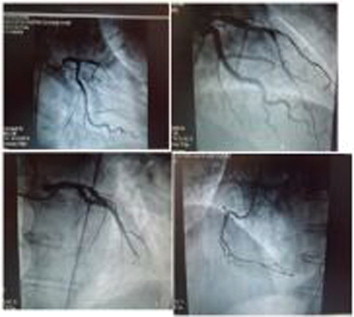We reported a case of primary percutaneous intervention (PCI) of occluded proximal left anterior descending artery(LAD) complicated with distal embolization to left circumflex artery(LCX) followed by cardiogenic shock associated with incessant ventricular fibrillation and subsequent coronary artery bypass grafting(CABG).
58 year- old male hypertensive, smoker, non diabetic patient admitted suffered from cardiopulmonary arrest. Immediately, he admitted to coronary care unit and advanced cardiopulmonary resuscitation(CPR) was started. Despite intensive CPR patient remain hemodynamically unstable the patient was brought for cardiac catheterization and coronary angiogram revealed total occlusion at proximal LAD with normal large caliber LCX. After crossing the lesion with balloon support, a bifurcating stenosis was found at the junction of medium sized first diagonal artery. A bare metal stent was deployed with side branch protection. During the procedure patient developed ventricular tachycardia(VT) and ventricular fibrillation(VF) which was managed with electrical shock. After restoration of flow in LAD, hemodynamic status of the patient gradually improved but suddenly, condition of the patient deteriorated. Angiogram revealed open first diagonal branch artery but total occlusion of LAD and a fresh thrombus at distal LCX with occluded flow. LAD was not passed with guiding wire and attempting to remove thrombus from LCX was not achieved because, the wire could not be passed up to thrombotic site. Since early reperfusion of the major left coronaries were thought to be essential for reducing the infarct area and rapid deterioration of patient with recurrent VF, surgical consultation was asked. Patient went into cardiogenic shock with frequent VT/VF. Surgery was started two hours after admission. On pump CABG was performed through a median sternotomy under intra aortic balloon support. 3 aorto saphenous vein graft(one for LAD,one diagonal and one for LCX) were anatomosed. The time required from the start of operation to reperfusion of the LAD after completing distal and proximal anastomosis was 60 minutes, and that to reperfusion of the LCX was 90 minutes. We attempted to wean the patient from percutaneous cardiopulmonary support after reperfusion of the LAD and LCX, but relinquished it because he developed hypotension and VT again. Operation time was 150 minutes and the patient was taken to the intensive care unit under the continuing use of IABP. With 3 days on ventilator along with inotropic support patient gradually improved with mild renal impairment. Patient had no significant neurological deficit. Post operative ECG shows R progression loss in precordial leads LVEF was 50%.





